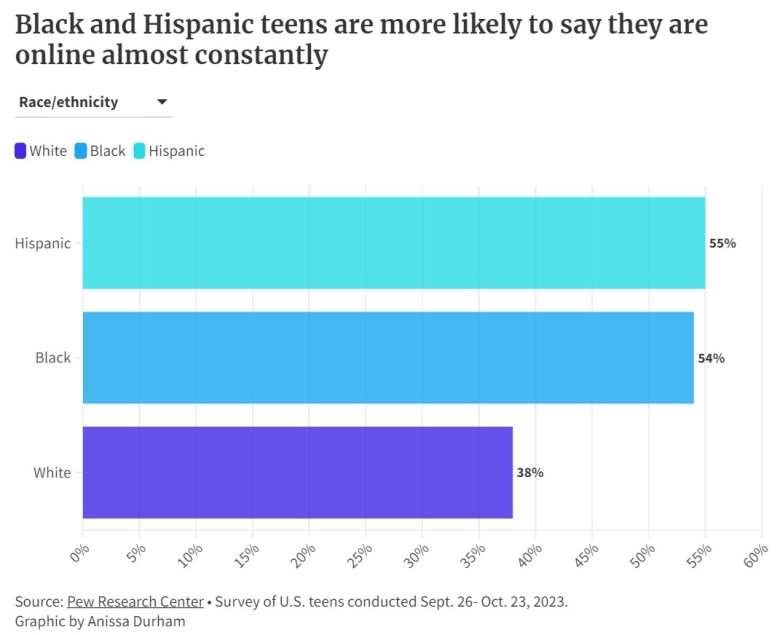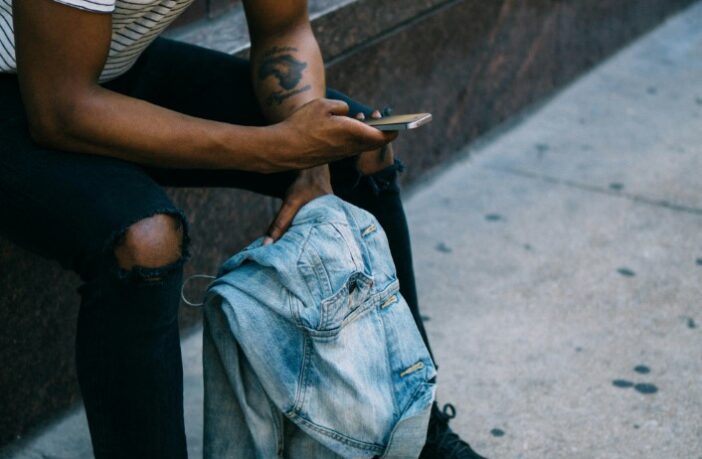By Anissa Durham
Word In Black
If you’re feeling suicidal or concerned that someone you know may be in danger of hurting themselves, call or text the National Suicide Prevention Lifeline at 988. The lifeline is available 24 hours a day, seven days a week and is staffed by trained counselors.
Research shows that teens who spend five or more hours on social media are more likely to suffer from devastating mental health issues, what is that number for teens and adolescents of color? (Photo: Unsplash/Derick Anies)
How much time do you spend on social media each day?
The use of social media has recently come under fire by politicians proposing a ban on TikTok and advising parents to set restrictions for their children. More and more research is coming out that says social media is linked to poor overall mental health. Teens often use popular platforms to connect with others and get support.
But, for Black teens, what is the danger?
 A Pew Research Center report on the number of teens and adolescents using their phones constantly. (Graphs courtesy of Word In Black)
A Pew Research Center report on the number of teens and adolescents using their phones constantly. (Graphs courtesy of Word In Black)
Here’s what we know
On average, teens spend about five hours a day on YouTube, TikTok and Instagram. In a 2023 Pew Research Center survey of 13- to 17-year-old teens, Black and Hispanic teens are more likely to say they are online almost constantly.
The 2023 Gallup Familial Adolescent Health Survey shows that teens who spent four to five hours on social media per day experienced higher rates of worry, sadness, anger and overall poor mental health. Higher social media use was associated with a significantly higher risk of mental health problems for teens.
Mental health outcomes are reportedly worse for teens with weak parental relationships. The strength of the relationship, in addition to regulation of screen time and supervision contributes to less social media use.
According to the Centers for Disease Control and Prevention, suicide rates for Black people aged 10-24 changed significantly from 2018 to 2021, with an increase from 8.2 percent to 11.2 percent. As a result, researchers have been exploring what factors are contributing to suicidal ideation and suicide among Black youth.
 Gallup poll that reflects the reported amount of anxiety teens feel who are restricted to four to five hours of social media. (Graphs courtesy of Word In Black)
Gallup poll that reflects the reported amount of anxiety teens feel who are restricted to four to five hours of social media. (Graphs courtesy of Word In Black)
A 2024 study explores how Black adolescents experience online racial discrimination and the link to suicidal ideation and traumatic stress. Researchers found an indirect association between online racial discrimination and suicidal ideation among the 525 participants.
Additionally, the Gallup survey found that teens who spent five hours or more on social media experienced two to three times higher rates of suicidal ideation, self-harm behavior in the past year, and poor body image.
A psychiatrist weighs in
Khadijah Booth Watkins, associate director of the Child and Adolescent Psychiatry training program at Massachusetts General Hospital, says racism and discrimination are considered an adverse childhood experience — alongside domestic violence, neglect, abuse and poverty.
 Gallop Family and adolescents research shows the more time spent on social media the greater the impact on mental health. (Graphs courtesy of Word In Black)
Gallop Family and adolescents research shows the more time spent on social media the greater the impact on mental health. (Graphs courtesy of Word In Black)
It’s important for teens to feel safe and connected, but the repeated exposure of people who look like them being victimized on social media is stressful. This reverberates into mental health issues, how the body functions and sleep disturbances.
“For Black and Brown kids, there’s an extra layer of being exposed to so much discrimination and racism … that makes them vulnerable to depression and anxiety,” she says.
Watkins also has concerns about how often teens are using social media and what it takes away from them. For example, social media often provides a false sense of reality, which can make it difficult for young people to have realistic expectations.
“Young people are incredibly impressionable,” she says.
Research on long-term effects is still underway. But Watkins says it’s becoming more challenging for young people to understand how to read between the lines on social media.
“What we’re seeing is a group of people who can’t tolerate adversity, frustration and an inability to understand the concept of delayed gratification,” she says. “You can scroll endlessly … and for young people, it stimulates this area of the reward system. It’s harder for them to pump the brakes … so they’re constantly chasing this sense of pleasure and gratification.”
Last summer, the U.S. Surgeon General, Vivek H. Murthy, released an advisory on social media and youth mental health. The 25-page report details the positive and negative impacts of social media on children and adolescents. And examines the different harms youth experience as they use social media.
A few weeks ago, Dr. Murthy published an op-ed in the New York Times, calling for a warning label to be placed on social media platforms — similar to warning labels placed on cigarettes.
“An advisory warning is great,” Watkins says. “But, I think the solution is going to be education around what you do. Modeling and teaching young people how to build healthy habits and a healthy relationship with social media.”
This article was originally published by Word In Black.



